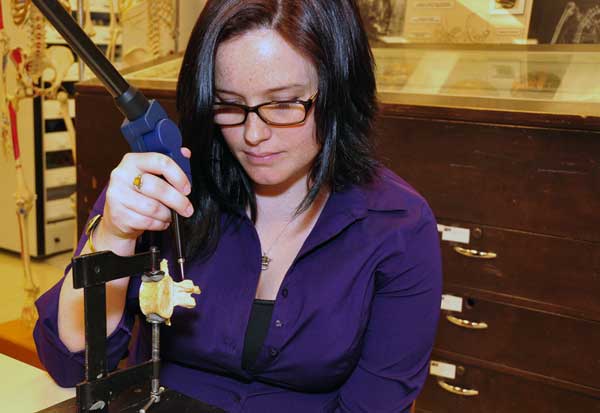The Ancestral Shape Hypothesis
Posted on: 17 March 2020 by Dr Kimberly Plomp in 2020 posts

Dr Kimberly Plomp, Marie Skłodowska-Curie Research Fellow in the Department of Archaeology, Classics and Egyptology, explores the ancestral source of a problem faced by many people today: back pain.
Back pain is a one of the most common health issues for humans, yet the causes of many back problems are still unknown. For decades, scientists have suggested that there may be a link between walking upright and back problems, since humans are more commonly afflicted with back pain than other primates, including our closest relatives, the chimpanzees.
In 2015, myself and my colleagues from Simon Fraser University, the University of Liverpool, the University of British Columbia, and the University of Iceland discovered the first quantified evidence showing a relationship between upright locomotion and spinal health. We found that those with lower back problems are more likely to have a spine shape similar to that of our closest ape relatives, the chimpanzees. We interpreted these findings to suggest that within normal human variation, some people have spinal shapes more similar to our last common ancestor shared with chimpanzees and that this ancestral shape does not adequately withstand the stresses of moving on two legs. We called this the Ancestral Shape Hypothesis.
Since then, we have found further evidence to support the Ancestral Shape Hypothesis. We expanded the study to include 3D analysis of the shape of vertebrae (the bones that make up the spine) of humans, great apes, and our extinct relatives (published in BMC Evolutionary Biology, December, 2019). The humans that have intervertebral disc herniations tend to have a shape that is statistically indistinguishable from chimpanzee vertebrae. They are also closer in shape to a majority of the fossil species.
On top of this, Prof Collard, Prof Dobney, and myself have also found evidence that having vertebrae with exaggerated adaptations to bipedalism may also increase your likelihood of back problems. We studied another back problem that can be identified in archaeological skeletons called spondylolysis. Spondylolysis is a fracture that can separate the back of a vertebrae from the front, and only happens in humans. We found that individuals with spondylolysis had traits that are exaggerated adaptations for bipedalism. This means that as our ancestors evolved to walk on two legs, some people went beyond the optimal shape to support walking on two legs and this shape may make people prone to the fractures that cause spondylolysis. We called this the Overshoot Hypothesis (to be published in Evolution, Medicine, and Public Health).
We can picture human vertebral shape variation as a bell-curve, with one end having a shape that is more ancestral and the other end having a shape that has exaggerated adaptations for walking on two legs. Where an individual’s vertebrae lie within this distribution has a bearing on their spinal health. At the centre of the range of variation are vertebrae that have the optimal shape for bipedalism and, therefore, have a lower probability of developing spinal pathologies in response to the stresses of walking on two legs. However, having vertebral that have either ancestral or an ‘overshot’ bipedal shape may increase your likelihood of developing back problems.
Evidence of injury and disease on human skeletons provide archaeologists with valuable insight into our ancestors’ health and lifestyles and can provide a lot of information about the health of a person or a population. This research in particular used archaeological skeletons because it allowed for large sample sizes without impacting living humans.
Discover more
Study in the Department of Archaeology, Classics and Egyptology at the University of Liverpool.
Keywords: ancestral shape hypothesis, archaeology, classics, egyptology, anthropology, back pain, spine, research, university, Liverpool.